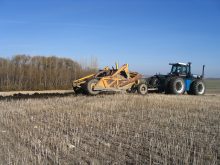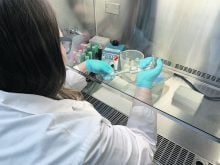Calgary company found a way to coat the urea after production, prior to distribution, making it cheaper and convenient
A new nitrification inhibitor that’s cheaper to produce and can be coated onto urea during manufacturing may reduce the cost of protecting nitrogen fertilizer.
Calgary-based Soilgenic Technologies produces NitroBlock, based on dicyandiamide technology, that is commonly used in fertilizer formulations as a nitrification inhibitor to slow the release of applied nitrogen into plant available forms.
“It’s a more efficient, enhanced DCD formulation. It has a heavier molecular weight. It’s a longer molecule,” said Jeff Ivan, President and Chief Executive Officer of Soilgenic Technologies.
Read Also

Saskatchewan puts crown land auction on hold
Auctions of Saskatchewan crown lease land are once again on hold.
He said NitroBlock keeps nitrogen in the stable ammonium stage and reduces the nitrification process, resulting in 10 times lower nitrate nitrogen levels in the soil compared to regular DCD, and over 80 times lower than untreated urea.
Soilgenic’s patented form of DCD can be used with urea, anhydrous ammonia, UAN and other ammonia-based products.
Ivan said the company’s testing found that 27 days after application, untreated nitrogen contains 81 parts per million of nitrate nitrogen, which is a form that can be lost due to leaching.
“The conventional DCD formulation was nine parts per million. So, it shows that DCD is very effective in reducing the production of nitrate nitrogen,” he said.
“NitroBlock was less than one part per million of nitrate in the soil. So that shows that all that nitrogen was held in the ammonium form in the soil, which is typically being protected from loss.”
A patented process that enables the upstream coating of NitroBlock onto urea where it’s produced, helps to reduce the price of the nitrification inhibitor.
“We can work with urea manufacturers to enhance their urea so that every ton of fertilizer that goes out the door will contain the enhanced efficiency,” Ivan said.
“It’s a very simple and easy process where they just set up a liquid spray system towards the end of their production process. So, it’s a good solution in terms of the factories because they don’t have to shut down their factories for a period of time while they’re implementing our technology.”
NitroBlock can be added to urea at retailers but applying it at urea plants can help take the pressure off retailers during busy times.
“You can only put so much of a coating onto the fertilizer itself before it becomes too wet,” Ivan said.
“If the fertilizer comes with the efficiency built into it then now the staff can say OK, let’s add a micronutrient, or a biological or something onto the fertilizer. This gives them more time and more room for adding other technologies.”
Additional savings for the NitroBlock nitrification inhibitor also comes from how it’s produced.
“We’re able to produce the finished products much at a lower cost, even cheaper than China, which is not typical. But we have a patent pending process right now with one of our technologies that is just a more efficient way of producing the molecule,” Ivan said.
“We’re much lower cost compared to current industry standards. In many cases we’re half the cost of other technologies that are on the market today.”
He said the NitroBlock-based product for UAN can be added at any point, because it is fully soluble it won’t fall out of suspension and sit at the bottom of the tank if it’s added long before application.
The NitroBlock-based product for anhydrous ammonia also has advantages over other advanced efficiency products on the market.
“We are the only formulation that is non-corrosive. There are two other enhanced efficiency technologies for ammonia, but both are corrosive,” Ivan said.
“Having a formulation that is noncorrosive is a big advantage for the fertilizer retail system and for farmers that use anhydrous ammonia.”
VisioN is the NitroBlock-based product for urea, Diamond N is the name for the UAN product, Drive N is used with Anhydrous ammonia, and N Bound is used with ammonia-based fertilizers.
Soilgenic also patented a phosphate enhancement technology called Phosgain, which is a polymer coating for phosphate fertilizer.
“Our Phosgain technology coats the phosphate and creates a protective barrier that works to protect the phosphate fertilizer from tie-up in the soil, with strong cations such as calcium, magnesium, and iron,” Ivan said.


















